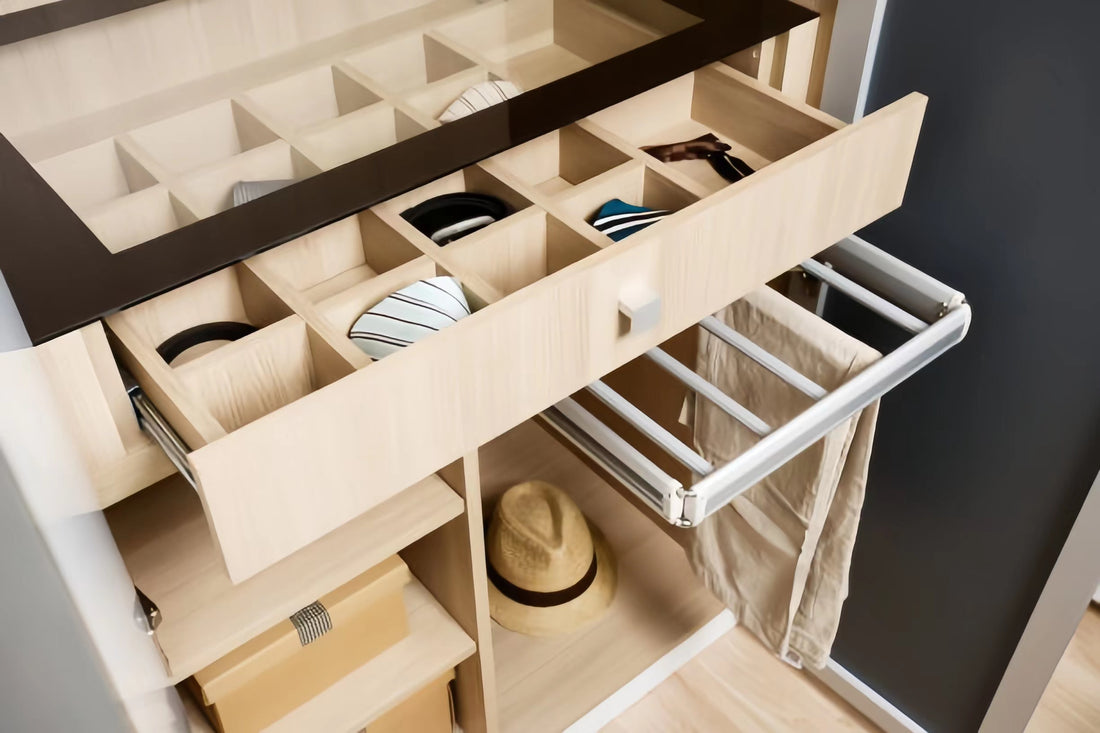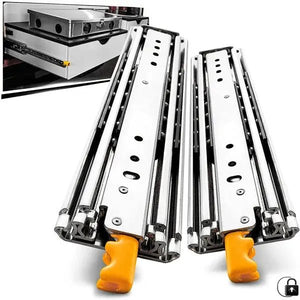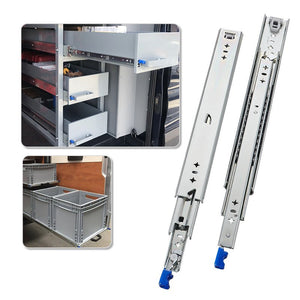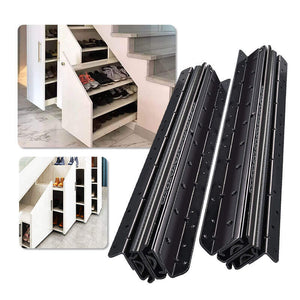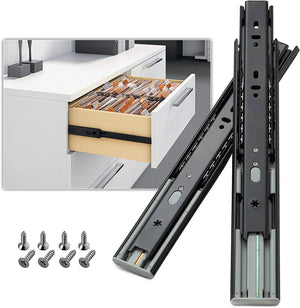Introduction
Drawer slides may not be the first thing that comes to mind when you think about furniture, but they are the unsung heroes of functionality. These unassuming components are responsible for the smooth gliding motion of drawers, making them an integral part of our daily lives. In this comprehensive guide, we will delve into the intricate world of drawer slides, exploring their types, mechanisms, and the factors that make them indispensable in furniture design and usability.

The Basics of Drawer Slides
What Are Drawer Slides?
Working Principle:
- The fundamental principle that underpins the operation of drawer slides is the concept of linear motion conversion. When you pull a drawer handle, the linear force you apply is translated into a smooth gliding motion, allowing the drawer to extend outward for easy access.
- Example: Think of it as the action of a train moving along its tracks. The tracks guide the train's wheels, ensuring a steady and controlled movement. Similarly, drawer slides provide the tracks and guidance necessary for the drawer to move smoothly.
Components of Drawer Slides:
To understand how this transformation occurs, let's break down the essential components of drawer slides:
- Tracks: These are the stationary components typically attached to the interior of the cabinet or furniture frame. They provide the foundation and path along which the drawer will travel.
- Rollers or Ball Bearings: These are the moving components attached to the sides or bottom of the drawer. They come into contact with the tracks and facilitate the smooth movement of the drawer. Rollers and ball bearings are often used interchangeably, and their selection depends on the specific type and design of the drawer slides.
- Slides: Slides are the intermediary components that connect the tracks and the rollers or ball bearings. They ensure that the linear motion generated by pulling the drawer handle is evenly distributed to the rollers or ball bearings.
Types of Drawer Slides:
Drawer slides come in various types, each with its own unique characteristics and applications. The three most common types are side-mount, under-mount, and bottom-mount slides, each catering to different design and functional needs.

-
Side-Mount Drawer Slides:These slides are typically installed on both sides of drawers and cabinets. They are a popular choice for various furniture styles, offering stability and ease of installation. There are three key advantages to using these slides.Firstly, they provide stability, making them ideal for heavy-duty drawers.Secondly, many side-mounted slides allow the drawer to fully extend, granting easy access to the entire contents of the drawer.Lastly, these slides are known for their simplicity in installation, making them a favorite among DIY enthusiasts.
However, it's important to consider their drawbacks. One notable drawback is their impact on the aesthetics of the drawer, as the hardware is visible when the drawer is opened due to installation on both sides.

- Under-Mount Drawer Slides:Additionally, side-mounted slides require space on the sides of the drawer and cabinet, which can limit design options in certain cases.Recessed slides are hidden underneath the drawer, making the slides invisible when the drawer is opened for a sleek, modern look. Recessed slides have several advantages:1. Drawer aesthetics: Since no hardware is visible when the drawer is open, these slides are highly regarded for their clean, unobtrusive appearance.2. Smooth operation: Recessed slides are known for their exceptionally smooth and quiet drawer movement, which enhances the user experience.3. Space-saving: They require less drawer-side clearance, which allows for greater design flexibility. However, we must consider the following drawbacks:1. Weight constraints: Bottom-mounted slides may have a lower weight capacity than side- or bottom-mounted slides, making them less suitable for heavy-duty applications.2 Installation complexity: Bottom-mounted slides can be more complex to install and may require precise alignment, which can pose a challenge during the installation process.
Choosing the Right Type:The choice between these types depends on your project's requirements. If aesthetics and space efficiency are crucial, under-mount slides may be ideal. For heavy-duty applications, side-mount or bottom-mount slides may be more appropriate. Always consider weight capacity, visibility of hardware, and installation complexity when making your selection.
Factors Influencing Drawer Slide Selection
Drawer Dimensions and Weight Capacity:
-
Selecting the appropriate drawer slides depends on factors such as drawer dimensions and the weight it will bear. Choosing the right slides ensures the longevity and functionality of your furniture.
-
Example: It's akin to choosing the right shoes for a hiking trip. You wouldn't wear sandals on a rugged trail; similarly, you wouldn't use light-duty slides on a heavy-duty drawer.
-
Consideration: Each drawer slide has a specified weight capacity, indicating the maximum load it can bear.
-
Importance: It's crucial to select slides with an appropriate weight rating to support the contents of your drawers without strain or malfunction.
-
Comparison: Choosing the right drawer slide weight capacity is akin to selecting a chair for its weight limit. Just as you wouldn't use a lightweight chair for heavy-duty purposes, you shouldn't use low-capacity slides for heavy drawers.
Material and Finish Options:
-
The material and finish of drawer slides play a crucial role in their performance and aesthetics. Understanding the available options helps you make an informed choice.
-
Comparison: Choosing the material and finish for drawer slides is akin to selecting the fabric and color for upholstery. It affects both the look and feel of the furniture.
- Consideration: The material and finish of the drawer slides impact both aesthetics and durability.
- Explanation: Drawer slides are available in various materials, including steel, aluminum, and plastic, with finishes like zinc plating or powder coating.
- Selection: Choose materials and finishes that match your furniture's design and intended use. Steel slides with corrosion-resistant finishes are common choices for durability.
Mounting Options:
- Consideration: Drawer slides come in various extension types, primarily full-extension and partial-extension.
- Explanation: Full-extension slides allow the drawer to extend fully out of the cabinet, providing complete access to its contents. Partial-extension slides, on the other hand, offer limited extension, typically leaving a portion of the drawer concealed within the cabinet.
- Application: Your choice depends on the specific needs of your project. Full-extension slides are ideal for maximizing storage space and easy access. Partial-extension slides may be suitable for applications where limited extension suffices.
-
The mounting method of drawer slides—whether side-mount, under-mount, or bottom-mount—impacts the overall design and functionality of your furniture.
-
Analogy: Consider it as selecting the right foundation for a house. The choice determines the stability and structure of the entire building.

Installing and Maintaining Drawer Slides
Installation Guide:
-
Installing drawer slides correctly is essential for smooth operation. This section provides a step-by-step guide for different types of slides, ensuring precise alignment and stability.
-
Example: Installing drawer slides is like assembling a puzzle. Each piece must fit perfectly to create a functional and aesthetically pleasing whole.
Maintenance and Troubleshooting:
-
To prolong the life of your drawer slides, regular maintenance is key. Learn how to troubleshoot common issues such as sticking, misalignment, or noise.
-
Comparison: Maintaining drawer slides is akin to maintaining a bicycle. Regular checks and lubrication keep them running smoothly, just as oiling a bike's chain ensures a smooth ride.
Conclusion
In conclusion, understanding how drawer slides work is pivotal for achieving functional and reliable drawers in your furniture projects. These silent heroes of furniture design operate seamlessly, allowing for effortless access to your belongings. Whether you're a DIY enthusiast or a professional designer, having a comprehensive grasp of drawer slides will empower you to create furniture that stands the test of time.
FAQ
1. How do drawer slides facilitate smooth drawer movement?
- Drawer slides use a combination of tracks, rollers or ball bearings, and slides to convert linear force into controlled motion. When you pull the drawer handle, the slides distribute the force to the rollers or ball bearings, allowing the drawer to glide smoothly along the tracks.
2. What are the common types of drawer slides, and how do they differ?
- The most common types of drawer slides include side-mount, under-mount, and bottom-mount slides. Side-mount slides are visible and provide stability, under-mount slides are concealed for a sleek look, and bottom-mount slides offer stability and easy access.
3. How do soft-close drawer slides work, and what are their benefits?
- Soft-close drawer slides feature dampers or hydraulic systems that control the closing speed, preventing drawers from slamming shut. These slides enhance safety, reduce noise, and extend the life of both the drawer and cabinet.
4. What factors should I consider when selecting drawer slides for my project?
- Consider factors like weight capacity, extension type (full-extension or partial-extension), self-closing or soft-close features, locking mechanisms, material, finish, and the specific needs of your furniture project.
5. Can I install drawer slides myself, or should I hire a professional?
- While installing drawer slides is a manageable DIY project, it requires precision and attention to detail. If you're comfortable with woodworking and have the necessary tools, you can install them yourself. However, for complex or large-scale projects, it may be advisable to seek professional assistance to ensure proper installation.

